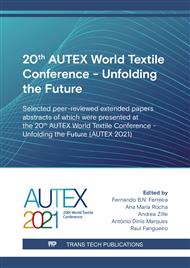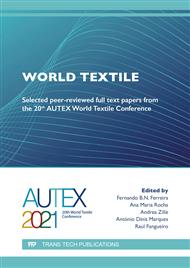[1]
Jackson, F. N. (1861) A history of a hand-made lace: dealing with the origin of lace, the growth of the great lace centres, the mode of manufacture, the methods of distinguishing and the care of various kinds of lace (1900). London: L.U. Gill; New York: C. Scribner's Sons.
DOI: 10.5479/sil.188451.39088003712759
Google Scholar
[2]
Henriques, A. C. S. (2010). No princípio estava o mar : Peniche : o património cultural, o turismo e o mar. (Dissertação de Mestrado não editada, em Lazer, Património e Desenvolvimento e não editada) Universidade de Coimbra, Portugal. Disponível em https://www.memoriamedia.net/bd_docs/transcricao_peniche/Tese.PDF. Acesso em 01/02/(2019).
DOI: 10.14195/978-989-26-0585-2_2
Google Scholar
[3]
CALADO, Mariano. (1994) Da ilha de Peniche, Edição de Autor, Lisboa.
Google Scholar
[4]
Bieger I., Carvalho C., & Montagna G. (2017) The Design Service as an Improvement Tool of the International Show of the Bobbin Lace from Peniche. In: Kantola J., Barath T., Nazir S., Andre T. (eds) Advances in Human Factors, Business Management, Training and Education. Advances in Intelligent Systems and Computing, vol 498. Springer, Cham. https://link.springer.com/chapter/10.1007/978-3-319-42070-7_54. Acesso em 01/02/(2019).
DOI: 10.1007/978-3-319-42070-7_54
Google Scholar
[5]
Cascudo, L.C. (1980) Dicionário do folclore brasileiro. 5. Ed. São Paulo: Melhoramentos.
Google Scholar
[6]
Drumond, T. B. P. (2006) Tecendo Vidas:
Cultura e Trabalho das Rendeiras da Prainha de Aquiraz-Ce (Dissertação de Mestrado não editada, Programa de Pós-Graduação em História), Universidade Federal do Ceara, Fortaleza, Ceará, Brasil. Disponível em: http://www.repositorio.ufc.br/bitstream/riufc/3349/1/2006_dis_tbpdrumond.pdf . Acesso em 01/02/(2019).
DOI: 10.22239/2317-269x.01653
Google Scholar
[7]
Brussi, Júlia Dias Escobar. (2009). Da renda roubada, à renda exportada: a produção e comercialização da renda de bilros em dois contextos cearenses. Dissertação de Mestrado não editada, em Antropologia Social na Universidade de Brasília. Disponível em: https://repositorio.unb.br/bitstream/10482/18559/1/2009_JuliaDiasEscobarBrussi.pdf Acesso em 01/02/(2019).
DOI: 10.18840/1980-8860/rvmd.v7n2p269-309
Google Scholar
[8]
Brizola, A. L. C; Bieger, I. C; Carvalho, C. (2015). Renda de bilros em Portugal e no Brasil: património e mercado. Anais
3° Colóquio de Pesquisa em Arquitetura e Urbanismo e Design Brasil-Portugal: UFU e UL. Disponível em: http://www.academia.edu/29391732/RENDA_DE_BILROS_EM_PORTUGAL_E_NO_BRASIL_PATRIM%C3%93NIO_E_MERCADO . Acesso em 01/02/(2019).
DOI: 10.5151/9786555065176-21
Google Scholar
[9]
Matsusaki, B. C. (2016) Trajetória de uma tradição: renda de bilros e seus enredos (Dissertação de Mestrado não editada, em Ciências do Programa de Pós-Graduação em Têxtil e Moda não editada) Universidade de São Paulo,
Escola de Artes, Ciências e Humanidades, São Paulo, São Paulo, Brasil. Disponível em: http://www.teses.usp.br/teses/disponiveis/100/100133/tde-11052016-111953/pt-br.php . Acesso em 01/02/(2019).
DOI: 10.11606/9788564842472
Google Scholar
[10]
Koskinen, Ilpo. Zimmerman, John. Binder, Thomas. Redström, Johan. Wensveen, Stephan. (2011). DESIGN RESEARCH THROUGH PRACTICE From the Lab, Field, and Showroom. Elsevier: China.
DOI: 10.1016/b978-0-12-385502-2.00006-7
Google Scholar



